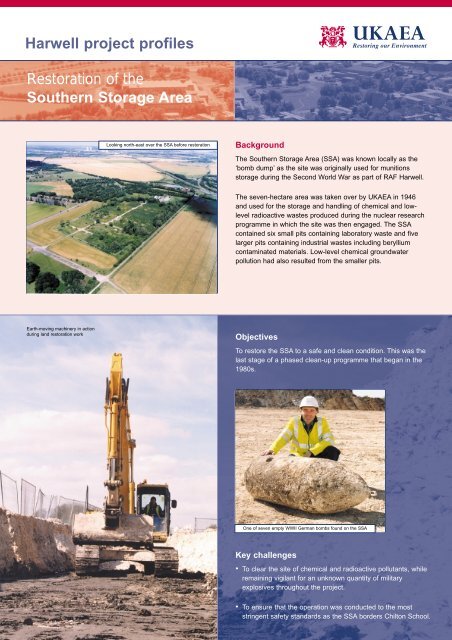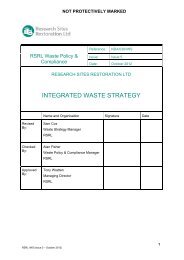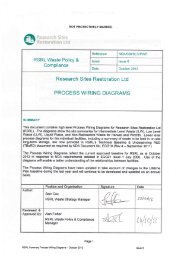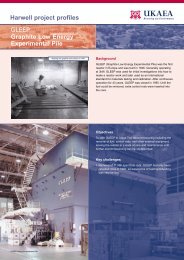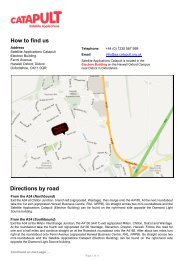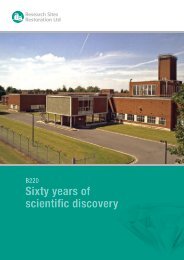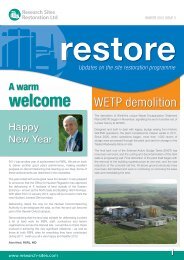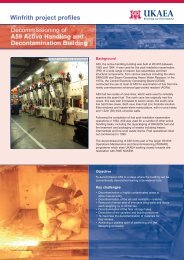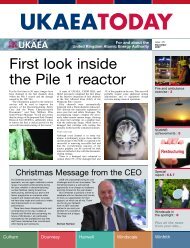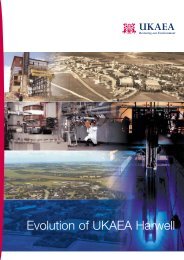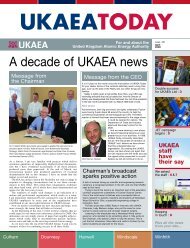Harwell project profiles Restoration of the Southern Storage Area
Harwell project profiles Restoration of the Southern Storage Area
Harwell project profiles Restoration of the Southern Storage Area
Create successful ePaper yourself
Turn your PDF publications into a flip-book with our unique Google optimized e-Paper software.
<strong>Harwell</strong> <strong>project</strong> <strong>pr<strong>of</strong>iles</strong><strong>Restoration</strong> <strong>of</strong> <strong>the</strong>Sou<strong>the</strong>rn <strong>Storage</strong> <strong>Area</strong>Looking north-east over <strong>the</strong> SSA before restorationBackgroundThe Sou<strong>the</strong>rn <strong>Storage</strong> <strong>Area</strong> (SSA) was known locally as <strong>the</strong>‘bomb dump’ as <strong>the</strong> site was originally used for munitionsstorage during <strong>the</strong> Second World War as part <strong>of</strong> RAF <strong>Harwell</strong>.The seven-hectare area was taken over by UKAEA in 1946and used for <strong>the</strong> storage and handling <strong>of</strong> chemical and lowlevelradioactive wastes produced during <strong>the</strong> nuclear researchprogramme in which <strong>the</strong> site was <strong>the</strong>n engaged. The SSAcontained six small pits containing laboratory waste and fivelarger pits containing industrial wastes including berylliumcontaminated materials. Low-level chemical groundwaterpollution had also resulted from <strong>the</strong> smaller pits.Earth-moving machinery in actionduring land restoration workObjectivesTo restore <strong>the</strong> SSA to a safe and clean condition. This was <strong>the</strong>last stage <strong>of</strong> a phased clean-up programme that began in <strong>the</strong>1980s.One <strong>of</strong> seven empty WWII German bombs found on <strong>the</strong> SSAKey challenges• To clear <strong>the</strong> site <strong>of</strong> chemical and radioactive pollutants, whileremaining vigilant for an unknown quantity <strong>of</strong> militaryexplosives throughout <strong>the</strong> <strong>project</strong>.• To ensure that <strong>the</strong> operation was conducted to <strong>the</strong> moststringent safety standards as <strong>the</strong> SSA borders Chilton School.
SolutionContractors clearing beryllium contaminated material from waste pitsThe site was completely excavated in 300mm deep layers withintensive surveying to ensure any wastes were detected andremoved. All <strong>of</strong> <strong>the</strong> pits were excavated inside double ventilatedcontainment structures that prevented <strong>the</strong> release <strong>of</strong> dusts to<strong>the</strong> environment. Air sampling stations were established at ninelocations around <strong>the</strong> perimeter and near <strong>the</strong> working zones toverify <strong>the</strong> effectiveness <strong>of</strong> <strong>the</strong> precautions.A groundwater treatment plant was established to contain andremove very low levels <strong>of</strong> chemical pollution in <strong>the</strong> groundwater.Procedures were agreed with RAF and Army Bomb Disposalteams to cover <strong>the</strong> discovery and safe disposal <strong>of</strong> munitionsduring <strong>the</strong> <strong>project</strong>. Munitions experts were included in <strong>the</strong>specialist <strong>project</strong> teams, which comprised staff from UKAEA andspecialist contractors RWE Nukem and VHE Construction.A transparent communications policy was adopted to keep <strong>the</strong>local community fully informed with all developments on <strong>the</strong><strong>project</strong>.Once <strong>the</strong> clean-up work was completed <strong>the</strong> area waslandscaped for potential future recreational use.Outcome• UKAEA successfully completed <strong>the</strong> biggest and most complexclean-up <strong>of</strong> its kind in <strong>the</strong> UK.• From a situation in June 2000 when <strong>the</strong> SSA contained a uniquemixture <strong>of</strong> pollutions and explosives, <strong>the</strong> area is now safe andclean.• The levels <strong>of</strong> chlorinated solvents in <strong>the</strong> groundwater below <strong>the</strong>site were so low that <strong>the</strong> groundwater treatment plant wasremoved.• Monitoring <strong>of</strong> local air, soils, road surfaces and groundwaterconfirmed that <strong>the</strong>re was no harmful impact on <strong>the</strong> localenvironment.• The transparent communications policy fostered an excellentrelationship with <strong>the</strong> staff and pupils <strong>of</strong> Chilton School, culminatingwith <strong>the</strong> planting <strong>of</strong> a tree by every school pupil at a specialceremony on <strong>the</strong> newly landscaped site in September 2002.TV personality John Craven (second from left) helped childrenfrom Chilton School to plant trees on <strong>the</strong> restored land• The unique nature <strong>of</strong> this decommissioning challenge requiredUKAEA to develop <strong>project</strong> teams with sub contractors thatharnessed a wide range <strong>of</strong> experience and skills and which havesubsequently set new standards in environmental restoration.Key facts• Timescales2 years planning and 2 years site implementation• Total soil shifted Over 250,000m 3• Waste material removed18,000m 3 (including 230m 3 <strong>of</strong> low levelradioactive waste)Wartime munitions uncovered• 1,300 live practice bombs• 7 German bomb casings• 13,000 rounds <strong>of</strong> ammunition• 30 land mines• 30 flares• 1 depth chargeContact:Nick Hance<strong>Harwell</strong> Public Relations ManagerTel: 01235 436909Email: nick.hance@ukaea.org.uk


